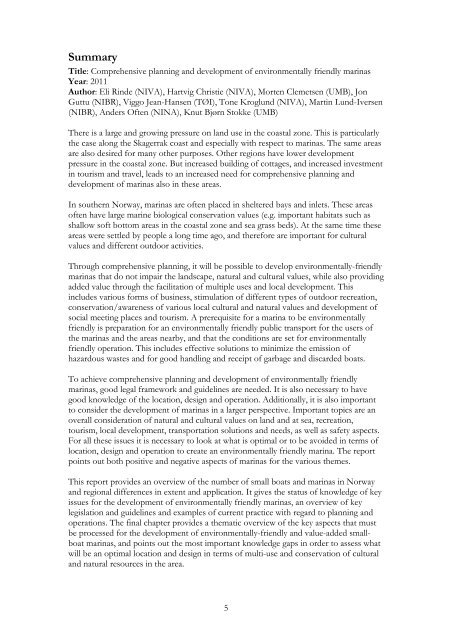Helhetlig planlegging og utvikling av miljøvennlige ... - ciens
Helhetlig planlegging og utvikling av miljøvennlige ... - ciens
Helhetlig planlegging og utvikling av miljøvennlige ... - ciens
Create successful ePaper yourself
Turn your PDF publications into a flip-book with our unique Google optimized e-Paper software.
Summary<br />
Title: Comprehensive planning and development of environmentally friendly marinas<br />
Year: 2011<br />
Author: Eli Rinde (NIVA), Hartvig Christie (NIVA), Morten Clemetsen (UMB), Jon<br />
Guttu (NIBR), Viggo Jean-Hansen (TØI), Tone Kr<strong>og</strong>lund (NIVA), Martin Lund-Iversen<br />
(NIBR), Anders Often (NINA), Knut Bjørn Stokke (UMB)<br />
There is a large and growing pressure on land use in the coastal zone. This is particularly<br />
the case along the Skagerrak coast and especially with respect to marinas. The same areas<br />
are also desired for many other purposes. Other regions h<strong>av</strong>e lower development<br />
pressure in the coastal zone. But increased building of cottages, and increased investment<br />
in tourism and tr<strong>av</strong>el, leads to an increased need for comprehensive planning and<br />
development of marinas also in these areas.<br />
In southern Norway, marinas are often placed in sheltered bays and inlets. These areas<br />
often h<strong>av</strong>e large marine biol<strong>og</strong>ical conservation values (e.g. important habitats such as<br />
shallow soft bottom areas in the coastal zone and sea grass beds). At the same time these<br />
areas were settled by people a long time ago, and therefore are important for cultural<br />
values and different outdoor activities.<br />
Through comprehensive planning, it will be possible to develop environmentally-friendly<br />
marinas that do not impair the landscape, natural and cultural values, while also providing<br />
added value through the facilitation of multiple uses and local development. This<br />
includes various forms of business, stimulation of different types of outdoor recreation,<br />
conservation/awareness of various local cultural and natural values and development of<br />
social meeting places and tourism. A prerequisite for a marina to be environmentally<br />
friendly is preparation for an environmentally friendly public transport for the users of<br />
the marinas and the areas nearby, and that the conditions are set for environmentally<br />
friendly operation. This includes effective solutions to minimize the emission of<br />
hazardous wastes and for good handling and receipt of garbage and discarded boats.<br />
To achieve comprehensive planning and development of environmentally friendly<br />
marinas, good legal framework and guidelines are needed. It is also necessary to h<strong>av</strong>e<br />
good knowledge of the location, design and operation. Additionally, it is also important<br />
to consider the development of marinas in a larger perspective. Important topics are an<br />
overall consideration of natural and cultural values on land and at sea, recreation,<br />
tourism, local development, transportation solutions and needs, as well as safety aspects.<br />
For all these issues it is necessary to look at what is optimal or to be <strong>av</strong>oided in terms of<br />
location, design and operation to create an environmentally friendly marina. The report<br />
points out both positive and negative aspects of marinas for the various themes.<br />
This report provides an overview of the number of small boats and marinas in Norway<br />
and regional differences in extent and application. It gives the status of knowledge of key<br />
issues for the development of environmentally friendly marinas, an overview of key<br />
legislation and guidelines and examples of current practice with regard to planning and<br />
operations. The final chapter provides a thematic overview of the key aspects that must<br />
be processed for the development of environmentally-friendly and value-added smallboat<br />
marinas, and points out the most important knowledge gaps in order to assess what<br />
will be an optimal location and design in terms of multi-use and conservation of cultural<br />
and natural resources in the area.<br />
5



